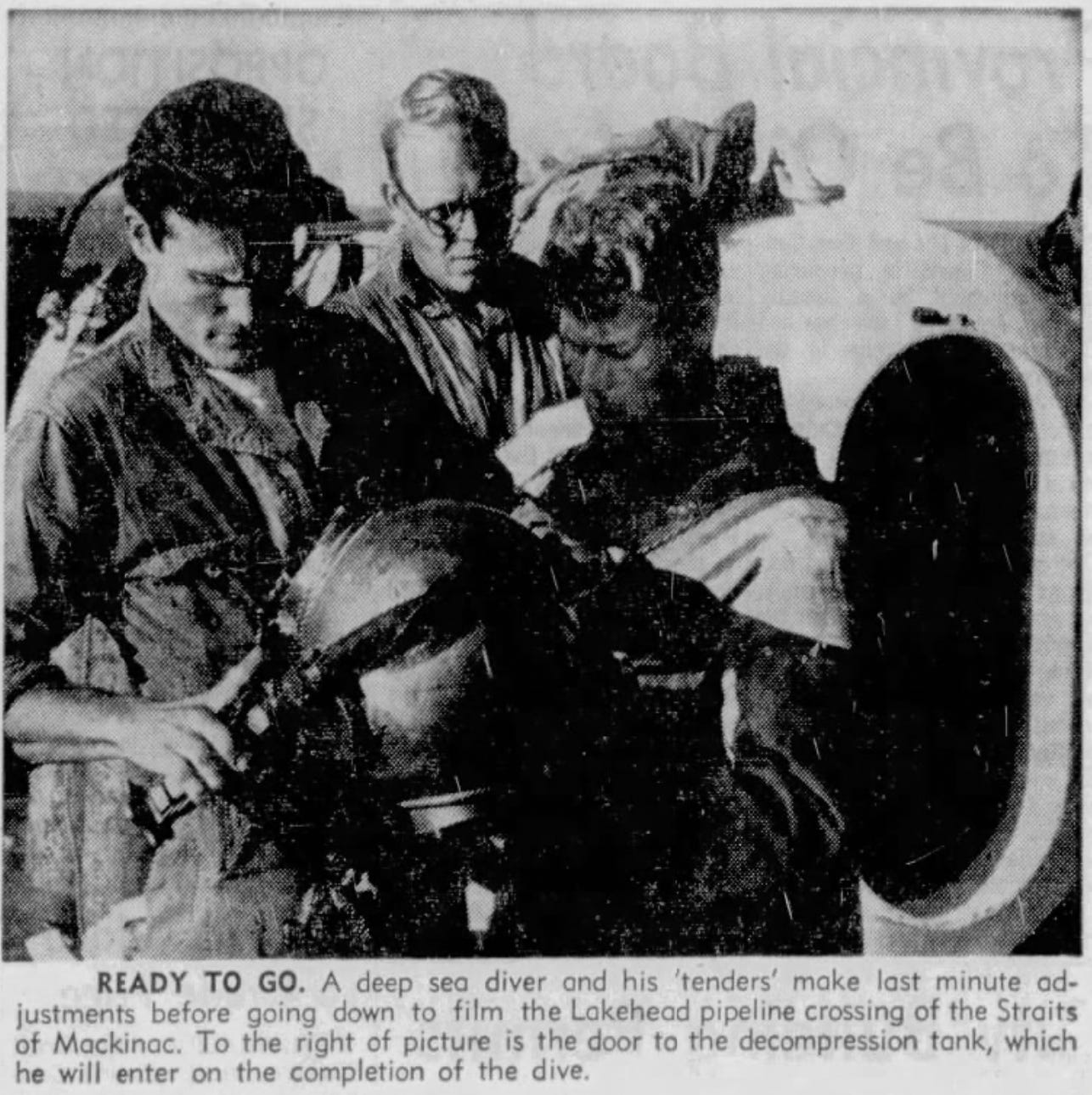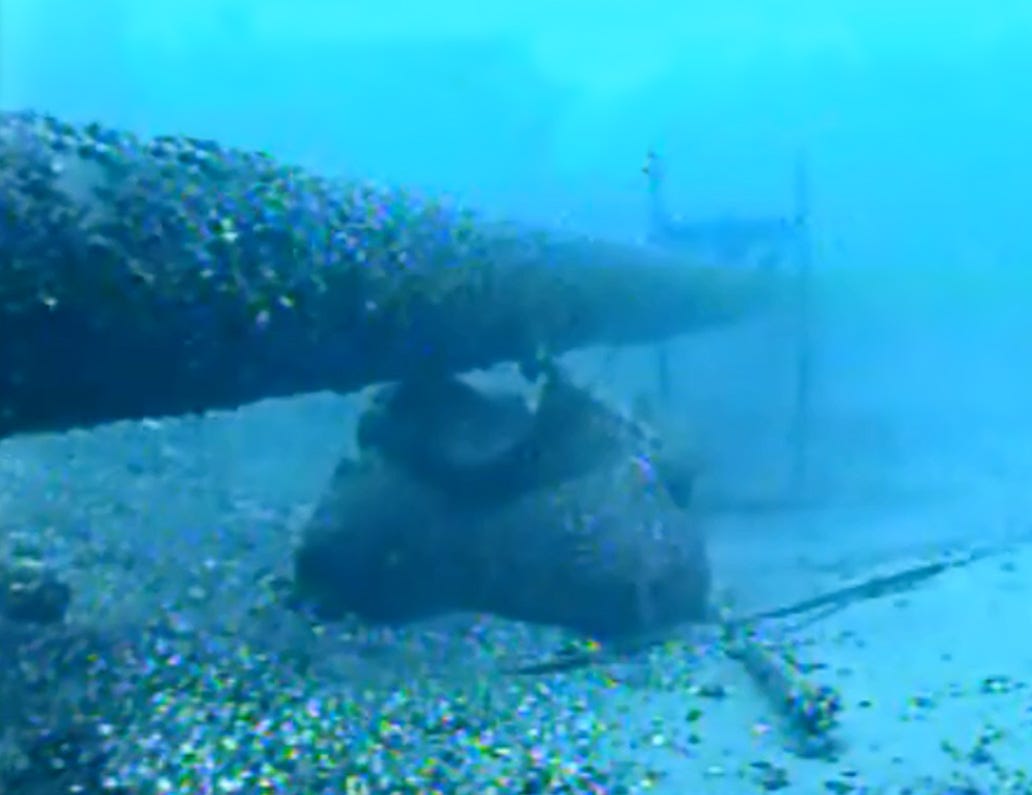While everyone was thinking about 2010 last week, I was thinking about 1963.
July 25 marked fifteen years since Enbridge’s disastrous 2010 spill into the Kalamazoo River. On Saturday, the 26th of last week, a bunch of my friends and others who care and fight for our environment gathered at Historic Bridge Park in Battle Creek, withstanding the boiling heat and humidity, so that they could remind everyone about Enbridge’s record of negligence. They delivered fiery and passionate remarks.
I was sorry to miss them, bogged down as I was with some research and writing I needed to get off my desk. That’s why I was thinking about 1963.
In the fall of that year, Enbridge—remember they were called Lakehead Pipe Line then—performed their first comprehensive underwater inspection of the dual pipelines beneath the Straits. They made a bit of a show of it, enough that the story appeared in newspapers from Calgary to Bay City, accompanied by photos of scuba divers and their camera equipment. Orchestrated by Bechtel, the contractor who oversaw the Line 5 project (you might recall that I’ve written about them before here and here), the filming required several teams of divers and took seven weeks. Lakehead officials announced that “the pipelines appear to be in good condition, but detailed examination of the film remains to be completed.”
And that’s almost the last anybody heard about the results of the inspection for fifty years.
Fast forward to 2014, when then-Attorney General Bill “Line 5’s days are numbered” Schuette convened a Petroleum Pipelines Task Force to study, among other things, the state of Line 5. One of the Task Force’s first actions was to craft a letter to Enbridge seeking detailed information about the condition of the pipeline, modifications Enbridge made to it over the years, and the company’s compliance with the 1953 easement, among other things.
Enbridge’s reply two months later provided some rather shocking admissions, all of which Enbridge tried to pass off as no big deal. For the first time since the line was constructed, the State learned that Enbridge had long known about erosion of the lakebed beneath the pipelines, leaving stretches of pipe unsupported. Enbridge did not share the 1963 footage with the State (on the flimsy excuse that the files are too large), but it is almost certain the films show evidence of erosion since our State officials learned later that Lakehead discovered seventeen unsupported spans in ‘63. Yet it was another twelve years before they first took action to address the problem by installing bags filled with grout to support the lines. Those efforts continued, at various intervals and in various ways, for the next forty years.
Except that Enbridge never informed the State of Michigan about any of this. So in 2019, when the Michigan Department of Natural Resources, at the direction of Governor Whitmer, requested more documents about these measures and the conditions of the line, the information was so troubling that in November 2020, Whitmer issued her Notice revoking Enbridge’s easement to operate the pipelines beneath the Straits.
You probably recall what happened next: Enbridge challenged the Governor’s order and filed its own suit against the Governor in federal court. Then Attorney General Nessel filed a separate suit against Enbridge. A year later, in 2021, when a U.S. Circuit Court judge ruled that Whitmer’s case must remain in federal court, the Governor voluntarily withdrew the case in the hopes that Nessel’s suit would remain in state court, where it had always been assumed Michigan’s case would receive a friendlier hearing.
It’s important we don’t forget that Enbridge has a documented 70-year record of failing to adhere to the basic provisions of a legal agreement with the State of Michigan.
At the time, that seemed like a reasonable decision; it is universally assumed that Enbridge has the advantage in the federal courts. But thinking more about the fifty-year interval between 1963 and 2014 and looking over Whitmer’s revocation Notice again, I can’t help but think we’ve perhaps lost an important part of the plot of this story. The strength of the Governor’s order, after all, was always its assertion that Enbridge violated the terms of the easement. It’s all there in the order in devastating detail: for almost the entire operating life of the pipeline, Enbridge ignored a 75-foot span requirement (at one point unilaterally deciding that 140 feet was sufficient); ignored warnings about compromised pipeline coating; disregarded the pipeline curvature limits stated in the easement. Perhaps worst of all, at no time—or so it appears—did Enbridge notify the State of Michigan about any of these conditions or the very few measures they took over the course of fifty years to address them. Enbridge simply went rogue.
Even more remarkably, Enbridge doesn’t really dispute any of this. They certainly don’t dispute that they are obligated to abide by the conditions of the easement. In response to the Petroleum Pipeline Task Force queries, for example, Enbridge quickly took measures to ensure they were in compliance with the 75-foot span requirement and even went out of their way to note that they addressed the issue within the 90 days (from the time of notice from the State) stipulated in the easement. So Enbridge readily and repeatedly concedes that it is bound by the conditions of the easement. What their court strategy has done instead is attempt to change the subject, from a simple matter of contract—the conditions agreed upon in the easement—to one of general pipeline safety. I’m not convinced they’re on very solid footing with that argument, even in the federal courts.
Unfortunately, when Whitmer withdrew her suit, the State also withdrew its claims about violations of the easement agreement. Nessel’s case doesn’t make that argument; it only argues that the easement was invalid from its inception because it violates the Public Trust doctrine. That’s an interesting and compelling argument for sure, but it’s also much subtler—and probably less legally tenable—than a broken contract. It’s unfortunate that what are essentially indisputable claims about Enbridge’s compliance with the basic conditions of the easement are no longer getting a hearing in court.
Admittedly, this is all Monday morning lawyering.1 But it’s important that these facts continue to get a hearing in the public square and regulatory proceedings. It’s important we don’t forget that Enbridge has a documented 70-year record of failing to adhere to the basic provisions of a legal agreement with the State of Michigan. Nevertheless, credulous lawmakers in 2018, ignoring the old adage “fool me once,” still chose to enter into a new agreement with Enbridge to build their preposterous tunnel. What makes anyone think Enbridge is going to uphold its end of that deal either? What makes anyone think their promises and assurances are even worth the paper on which they’re written? We’ve got a few weeks left to make our voices heard to the Department of Energy, Great Lakes, and the Environment (EGLE) regarding the tunnel permit. There are plenty of good reasons for EGLE to deny it.
At the top of that list should be the simple but undeniable fact that we just can’t trust that they’ll do what they say.
I’m an English professor, not a lawyer.





According to Violation Tracker, Enbridge and their subsidiaries have had 107 environmental violations in the past 25 years, which averages one environmental violation every three months.
That alone is reason enough for EGLE to deny their permit, as it clearly shows Enbridge just considers environmental violation penalties and fines as a cost of doing business.
Enbridge can move their pipelines. We cannot move the Great Lakes.